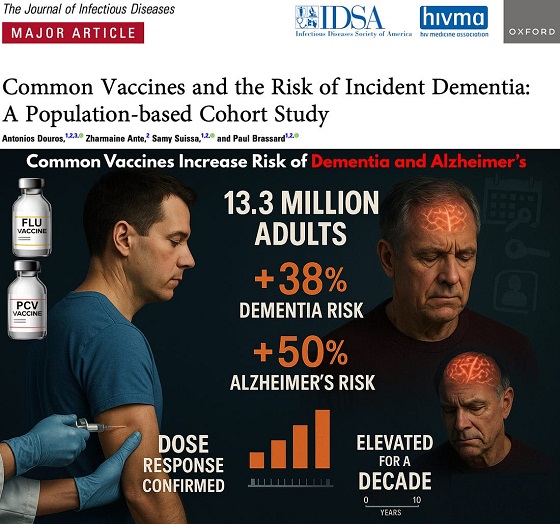Brownstone Institute
Twenty Grim Realities Unearthed by Lockdowns

From the Brownstone Institute
BY
It’s common now to speak of the before times in contrast to the after times. The turning point was of course March 16, 2020, the day of 15 Days to Flatten the Curve, though authoritarian trends predate that. Rights were suddenly broadly throttled, even religious rights. We were told to conduct every aspect of our lives in accordance with the priorities of the bio-medical security state.
Very few people anticipated such a shocking development. It was the onset of a new state-conducted war and the enemy was something we could not see and hence could be anywhere. No one has ever doubted the omnipresence of potentially dangerous pathogens but now we were being told that life itself depended entirely on avoidance of them and the only guide going forward would be public-health authorities.
Everything changed. Nothing is the same. The trauma is real and lasting. The claim of “15 Days” was revealed to be a ruse. The emergency lasted three years and then some. The people and machinery that did this are still in power. The pick to head the CDC has a long track record of enabling and cheering the lockdowns and all that followed.
It’s a helpful exercise to summarize the new things we’ve all discovered in these years. Together they account for why the world seems different and why we all feel and think differently now than we did just a few years ago.
Twenty terrible realities unearthed by lockdowns
1. Surveillance and censorship by Big Tech. The resistance eventually found each other but it took months and years. A censorship regime descended on all major social platforms, technologies designed with the intention of keeping us more connected and expanding the range of opinion we could experience. We did not know it was happening, but we eventually learned of the crackdown, which is why so much of us felt so alone. Others could not hear us and we could not hear them. The regime faces a bold court challenge on many fronts but it still goes on today, with all but Twitter constantly policing their networks in ways that are unpredictably authoritarian. We have ironclad evidence now that they are all captured.
2. Power and influence of Big Pharma. It was April 2020 when someone asked me if the goal of the vaccine produced by the pharmaceutical cartel was really behind the lockdowns. The idea would be to terrify us and ruin our lives until we were begging for shots. I thought the whole idea was insane and that the corruption could not possibly reach this deep. I was wrong. Pharma had been at work on a vaccine since January of that year and called in every form of purchased influence to eventually make them mandatory. Now we know that the major regulators are wholly owned and controlled, to the point that necessity, safety, and efficacy don’t really matter.
3. Government propaganda by Big Media. It was relentless from day one: the major media proved hardcore partisans of Anthony Fauci. The powers that be could tap the New York Times, National Public Radio, Washington Post, and all the rest, whenever and however they wanted. Later the media was deployed to demonize those who violated lockdowns, refused masks, and resisted the shots. Gone was the idea that “democracy dies in darkness” and the “paper of record” replaced by darkness itself and constant propaganda. They showed no real curiosity of the other side. The Great Barrington Declaration itself began as an effort to educate journalists but only a few dared even show up. Now we get it: the mainstream media too is wholly owned and completely compromised. They already knew what to report and how to report it. Nothing else mattered.
4. Corruption of public health. Who in their right minds would have predicted that the CDC and NIH, not to mention the World Health Organization, would be deployed as frontline workers in the imposition of totalitarian control? Some observers perhaps predicted this but implausibly so. But in fact it was these agencies which were responsible for all the absurd protocols from closing hospitals to non-Covid cases, putting up Plexiglas everywhere, keeping schools closed, demonizing repurpose therapeutics, masking toddlers, and forcing shots. They knew no limits to their power. They revealed themselves to be faithful agents of the hegemon.
5. Consolidation of industry. Free enterprise is supposed to be free but when workers, industries, and brands were divided between essential and nonessential, where were the howls from Big Business? They weren’t there. They proved willing to put profit ahead of the system of competition. So long as they benefited from the system of consolidation, cartelization, and centralization, they were fine with it. The big-box stores got to wipe out the competition and gain a leg up in industrial standing. Same with remote learning platforms and digital technology. The biggest businesses proved to be the worst enemies of real capitalism and the biggest friends of corporatism. As for arts and music: we know now that the elites consider them dispensable.
6. Influence and power of administrative state. The Constitution established three branches of government but lockdowns were not managed by any of them. Instead it was a fourth branch that has grown up over the decades, the permanent class of bureaucrats that no one elected and no one from the public controls. These permanent “experts” were completely unleashed and unhinged with no check on their power, and they cranked out protocols by the hour and enforced them as legislatures, judges, and even presidents and governors stood by powerless and in awe. We know now that there was a coup d’etat on March 13, 2020 that transferred all power to the national security state but we certainly did not know it then. The edict was classified. The administrative state still rules the day.
7. Cowardice of intellectuals. The intellectuals are the most free to speak their minds of any group. Indeed that is their job. Instead, they stayed quiet for the most part. This was true of right and left. The pundits and scholars just went along with the most egregious attacks on human rights in this generation if not in all living memory. We employ these people to be independent but they proved themselves to be anything but that. We stood by in shock as even famed civil libertarians looked out at the suffering and said “This is fine.” A whole generation among them is today completely discredited. And by the way, the few who did stand up were called horrible names and often lost their jobs. Others took note of this reality and decided instead to behave by staying quiet or echoing the ruling-class line.
8. Pusillanimity of universities. The origin of modern academia is with the sanctuaries from war and pestilence so that great ideas could survive even the worst of times. Most universities – only a handful excepted – completely went along with the regime. They closed their doors. They locked students in their dormitories. They denied paying customers in-person education. Then came the shots. Millions were jabbed unnecessarily and could only refuse on pain of being kicked out of degree programs. They showed a complete lack of principle. Alumni should take note and so should parents who are considering where to send their high school seniors next year.
9. Spinelessness of think tanks. The job of these huge nonprofits is to test the boundaries of acceptable opinion and drive the policy and intellectual world in the direction of progress for everyone. They are also supposed to be independent. They don’t depend on tuition or political favor. They can be bold and principled. So where were they? Almost without exception they clammed up or became craven apologists for the lockdown regime. They waited and waited until the coast was clear and then eked out little opinions that had little impact. Were they just being shy? Not likely. The financials tell a different story. They are supported by the very industries that stood to benefit from the egregious policies. Donors who believe in freedom should take note!
10. Madness of crowds. We’ve all read the classic book Extraordinary Popular Delusions and the Madness of Crowds but we thought it was a chronicle of the past and probably impossible now. But within an instant, mobs of people fell into medieval-style panics, hunting down non-compliers and hiding from the invisible miasma. They had a mission. They were ferreting out dissidents and ratting out the non-compliers. None of this would have happened otherwise. Just like in the Cultural Revolution of China, these would-be members of the Red Guard became foot soldiers for the state. Mathias Desmet’s book on Mass Formation now stands as a classic explanation of how a population devoid of meaningful lives can turn these sorts of political frenzies into deluded crusades. Most of our friends and neighbors went along.
11. Lack of ideological conviction of both right and left. Both right and left betrayed their ideals. The right abandoned its affections for limited government, free enterprise, and the rule of law. And the left turned against its traditional stand for civil liberties, equal freedoms, and free speech. They all became compromised, and they all made up fake rationales for this pathetic situation. Had this all began under a Democrat, the Republicans would have been screaming. Instead they went quiet. Then the Covid regime passed to a Democrat and so they stayed quiet while the Republicans, embarrassed at their previous silence, stayed silent for far too long. Both sides proved ineffective and toothless throughout.
12. Sadism of the ruling class. The kids were denied a year or two of school in some locations. People missed medical diagnostics. Weddings and funerals were on Zoom. The aged were forced into desperate loneliness. The poor suffered. People turned to substance abuse and put on added pounds. The working classes were exploited. Small businesses were wrecked. Millions were forced to move and millions more were displaced from their jobs. The ruling class that advertised its wonderful altruism and public spiritedness became callous and completely disregarded all this suffering. Even when the data poured in about suicide ideation and mental illness from loneliness, it made no difference. They could not muster any concern. They changed nothing. The schools stayed closed and the travel restrictions stayed in place. Those who pointed this out were called terrible names. It was a form of grotesque sadism of which we did not know they were capable.
13. The real-life problem of massive class inequality. Would any of this have happened 20 years ago when a third of the workforce was not privileged enough to take their work home and pretend to produce from laptops? Doubtful. But by 2020, there had developed an overclass that was completely disconnected from the lives of those who work with their hands for a living. But the overclass didn’t care that they had to face the virus bravely and first. These workers and peasants did not have privileges and apparently they didn’t matter much. When it came time for the shots, the overclass wanted their health care workers, pilots, and delivery people to get them too, all in the interest of purifying society of germs. Huge wealth inequalities turn out to make a big difference in political outcomes, especially when one class is forced to serve the other in lockdowns.
14. The cravenness and corruption of public education. A universal education was the proudest achievement of progressives one hundred years ago. We all assumed it was the one thing that would be protected above all else. The kids would never be sacrificed. But then for no good reason, the schools were all closed. The labor unions representing the teachers rather liked their extended paid holiday and tried to make it last as long as possible, as the students got ever further behind in their studies. These are schools for which people paid for with their taxes for many years but no one promised a rebate or any compensation. Homeschooling went from existing under a legal cloud to being suddenly mandatory. And when they opened back up, the kids faced mass silencing with masks.
15. Enabling power of central banking to fund it all. From March 12, 2020, and onward, the Federal Reserve deployed every power to serve as a Congressional printing press. It slammed rates back to zero. It eliminated (eliminated!) reserve requirements for banks. It flooded the economy with fresh money, eventually reaching a peak of 26 percent expansion or $6.2 trillion in total. This of course later translated into price inflation that quickly ate away the actual purchasing power of all that free stimulus dispensed by government, thus harming on net both producers and consumers. It was a great head fake, all made possible by the central bank and its powers. Further damage came to the structure of production by a prolongation of low interest rates.
16. The shallowness of the faith communities. Where were the churches and synagogues? They closed their doors and kept out the people they had sworn to defend. They canceled holy days and holiday celebrations. They utterly and completely failed to protest. And why? Because they went along with the propaganda that ceasing their ministries was consistent with public health priorities. They went along with the state and media claim that their religions were deeply dangerous to the public. What this means is that they don’t really believe in what they claim to believe. When the opening finally came, they discovered that their congregations had dramatically shrunk. It’s no wonder. And who among them did not go along? It was the supposed crazy and odd ones: the Amish, the estranged Mormons, and the Orthodox Jews. How non-mainstream they are. How marginal! But apparently they were among the only ones whose faith was strong enough to resist the demands of princes.
17. The limitations on travel. We didn’t know the government had the power to limit our travel but they did it anyway. First it was internationally. But then it became domestic. For a few months there, it was hard to cross state lines because of the demands that everyone who did so had to quarantine for a fortnight. It was strange because we didn’t know what was and what was not legal nor did we know the enforcement mechanism. It turned out to be a training exercise for what we know now they really want, which is 15-minute cities. Apparently a people on the move are harder to control and corral. We were being acculturated toward a more medieval and tribal existence, staying put so that our masters can keep tabs on us.
18. The tolerance for segregation. Vaccine uptake was certainly disproportionate by race and income. Richer and whiter populations went along but some 40 percent of the non-white and poorer communities didn’t trust the jab and refused. That did not stop 5 major cities from imposing vaccine segregation and enforcing it with police power. For a time, major cities were segregated with disparate impact by race. I don’t recall a single article in a major newspaper that pointed this out, much less decried it. So much for public accommodations and so much for enlightenment! Segregation turns out to be just fine so long as it fits with government priorities – same now as it was in the bad old days.
19. The goal of a social credit system. It is not paranoia to speculate that all this segregation was really about the creation of a vaccine passport system running off a national base, the one they want very much to implement. And part of this is the real and long-term goal of creating a China-style social credit system that would make your participation in economic and social life contingent on political compliance. The CCP has mastered the art and imposed totalitarian control. We know for sure now that major aspects of the pandemic response were scripted in Beijing and imposed through the influence of China’s ruling class. It is completely reasonable to assume that this is the real goal of vaccine passports and even Central Bank Digital Currency.
20. Corporatism as the system under which we live, giving lie to existing ideological systems. For many generations, the great debate has been between capitalism and socialism. All the while, the real goal has passed us by: the institutionalization of an interwar-style corporatist state. This is where property is nominally private and concentrated in only top industries in major sectors but publicly controlled with an eye to political priorities. This is not traditional socialism and it certainly isn’t competitive capitalism. It is a social, economic, and political system designed by the ruling class to serve its interests above all else. Here is the main threat and the existing reality but it is not well understood by either right or left. Not even libertarians seem to get this: they are so attached to the public/private binary that they have blinded themselves to the merger of the two and the ways in which major corporate players are actually driving the advance of statism in their own interests.
If you haven’t changed your thinking over the last three years, you are a prophet, indifferent, or asleep. Much has been revealed and much has changed. To meet these challenges, we must do so with our eyes wide open. The greatest threats to human liberty today are not the ones of the past and they elude easy ideological categorization. Further, we have to admit that in many ways the plain human desire to live a fulfilling life in freedom has been subverted. If we want our freedoms back, we need to have a full understanding of the frightening challenges before us.
Brownstone’s work and influence in this regard is far beyond any that we’ve told publicly. You would be astonished at the extent of it. The times demand circumspection in overt institutional aggrandizement.
We are grateful to our donors for having faith in the power of ideas. We are daily amazed at the ability of passionate and scrupulous writers and intellectuals to make a real difference for the cause of freedom. Please, if you can, join our donor community to keep the momentum going, for the hill is perhaps the steepest we’ve climbed in our lives. We have no “development department” and no corporate or government benefactors: you can make a difference.
Brownstone Institute
The Unmasking of Vaccine Science

From the Brownstone Institute
By
I recently purchased Aaron Siri’s new book Vaccines, Amen. As I flipped though the pages, I noticed a section devoted to his now-famous deposition of Dr Stanley Plotkin, the “godfather” of vaccines.
I’d seen viral clips circulating on social media, but I had never taken the time to read the full transcript — until now.
Siri’s interrogation was methodical and unflinching…a masterclass in extracting uncomfortable truths.
A Legal Showdown
In January 2018, Dr Stanley Plotkin, a towering figure in immunology and co-developer of the rubella vaccine, was deposed under oath in Pennsylvania by attorney Aaron Siri.
The case stemmed from a custody dispute in Michigan, where divorced parents disagreed over whether their daughter should be vaccinated. Plotkin had agreed to testify in support of vaccination on behalf of the father.
What followed over the next nine hours, captured in a 400-page transcript, was extraordinary.
Plotkin’s testimony revealed ethical blind spots, scientific hubris, and a troubling indifference to vaccine safety data.
He mocked religious objectors, defended experiments on mentally disabled children, and dismissed glaring weaknesses in vaccine surveillance systems.
A System Built on Conflicts
From the outset, Plotkin admitted to a web of industry entanglements.
He confirmed receiving payments from Merck, Sanofi, GSK, Pfizer, and several biotech firms. These were not occasional consultancies but long-standing financial relationships with the very manufacturers of the vaccines he promoted.
Plotkin appeared taken aback when Siri questioned his financial windfall from royalties on products like RotaTeq, and expressed surprise at the “tone” of the deposition.
Siri pressed on: “You didn’t anticipate that your financial dealings with those companies would be relevant?”
Plotkin replied: “I guess, no, I did not perceive that that was relevant to my opinion as to whether a child should receive vaccines.”
The man entrusted with shaping national vaccine policy had a direct financial stake in its expansion, yet he brushed it aside as irrelevant.
Contempt for Religious Dissent
Siri questioned Plotkin on his past statements, including one in which he described vaccine critics as “religious zealots who believe that the will of God includes death and disease.”
Siri asked whether he stood by that statement. Plotkin replied emphatically, “I absolutely do.”
Plotkin was not interested in ethical pluralism or accommodating divergent moral frameworks. For him, public health was a war, and religious objectors were the enemy.
He also admitted to using human foetal cells in vaccine production — specifically WI-38, a cell line derived from an aborted foetus at three months’ gestation.
Siri asked if Plotkin had authored papers involving dozens of abortions for tissue collection. Plotkin shrugged: “I don’t remember the exact number…but quite a few.”
Plotkin regarded this as a scientific necessity, though for many people — including Catholics and Orthodox Jews — it remains a profound moral concern.
Rather than acknowledging such sensitivities, Plotkin dismissed them outright, rejecting the idea that faith-based values should influence public health policy.
That kind of absolutism, where scientific aims override moral boundaries, has since drawn criticism from ethicists and public health leaders alike.
As NIH director Jay Bhattacharya later observed during his 2025 Senate confirmation hearing, such absolutism erodes trust.
“In public health, we need to make sure the products of science are ethically acceptable to everybody,” he said. “Having alternatives that are not ethically conflicted with foetal cell lines is not just an ethical issue — it’s a public health issue.”
Safety Assumed, Not Proven
When the discussion turned to safety, Siri asked, “Are you aware of any study that compares vaccinated children to completely unvaccinated children?”
Plotkin replied that he was “not aware of well-controlled studies.”
Asked why no placebo-controlled trials had been conducted on routine childhood vaccines such as hepatitis B, Plotkin said such trials would be “ethically difficult.”
That rationale, Siri noted, creates a scientific blind spot. If trials are deemed too unethical to conduct, then gold-standard safety data — the kind required for other pharmaceuticals — simply do not exist for the full childhood vaccine schedule.
Siri pointed to one example: Merck’s hepatitis B vaccine, administered to newborns. The company had only monitored participants for adverse events for five days after injection.
Plotkin didn’t dispute it. “Five days is certainly short for follow-up,” he admitted, but claimed that “most serious events” would occur within that time frame.
Siri challenged the idea that such a narrow window could capture meaningful safety data — especially when autoimmune or neurodevelopmental effects could take weeks or months to emerge.
Siri pushed on. He asked Plotkin if the DTaP and Tdap vaccines — for diphtheria, tetanus and pertussis — could cause autism.
“I feel confident they do not,” Plotkin replied.
But when shown the Institute of Medicine’s 2011 report, which found the evidence “inadequate to accept or reject” a causal link between DTaP and autism, Plotkin countered, “Yes, but the point is that there were no studies showing that it does cause autism.”
In that moment, Plotkin embraced a fallacy: treating the absence of evidence as evidence of absence.
“You’re making assumptions, Dr Plotkin,” Siri challenged. “It would be a bit premature to make the unequivocal, sweeping statement that vaccines do not cause autism, correct?”
Plotkin relented. “As a scientist, I would say that I do not have evidence one way or the other.”
The MMR
The deposition also exposed the fragile foundations of the measles, mumps, and rubella (MMR) vaccine.
When Siri asked for evidence of randomised, placebo-controlled trials conducted before MMR’s licensing, Plotkin pushed back: “To say that it hasn’t been tested is absolute nonsense,” he said, claiming it had been studied “extensively.”
Pressed to cite a specific trial, Plotkin couldn’t name one. Instead, he gestured to his own 1,800-page textbook: “You can find them in this book, if you wish.”
Siri replied that he wanted an actual peer-reviewed study, not a reference to Plotkin’s own book. “So you’re not willing to provide them?” he asked. “You want us to just take your word for it?”
Plotkin became visibly frustrated.
Eventually, he conceded there wasn’t a single randomised, placebo-controlled trial. “I don’t remember there being a control group for the studies, I’m recalling,” he said.
The exchange foreshadowed a broader shift in public discourse, highlighting long-standing concerns that some combination vaccines were effectively grandfathered into the schedule without adequate safety testing.
In September this year, President Trump called for the MMR vaccine to be broken up into three separate injections.
The proposal echoed a view that Andrew Wakefield had voiced decades earlier — namely, that combining all three viruses into a single shot might pose greater risk than spacing them out.
Wakefield was vilified and struck from the medical register. But now, that same question — once branded as dangerous misinformation — is set to be re-examined by the CDC’s new vaccine advisory committee, chaired by Martin Kulldorff.
The Aluminium Adjuvant Blind Spot
Siri next turned to aluminium adjuvants — the immune-activating agents used in many childhood vaccines.
When asked whether studies had compared animals injected with aluminium to those given saline, Plotkin conceded that research on their safety was limited.
Siri pressed further, asking if aluminium injected into the body could travel to the brain. Plotkin replied, “I have not seen such studies, no, or not read such studies.”
When presented with a series of papers showing that aluminium can migrate to the brain, Plotkin admitted he had not studied the issue himself, acknowledging that there were experiments “suggesting that that is possible.”
Asked whether aluminium might disrupt neurological development in children, Plotkin stated, “I’m not aware that there is evidence that aluminum disrupts the developmental processes in susceptible children.”
Taken together, these exchanges revealed a striking gap in the evidence base.
Compounds such as aluminium hydroxide and aluminium phosphate have been injected into babies for decades, yet no rigorous studies have ever evaluated their neurotoxicity against an inert placebo.
This issue returned to the spotlight in September 2025, when President Trump pledged to remove aluminium from vaccines, and world-leading researcher Dr Christopher Exley renewed calls for its complete reassessment.
A Broken Safety Net
Siri then turned to the reliability of the Vaccine Adverse Event Reporting System (VAERS) — the primary mechanism for collecting reports of vaccine-related injuries in the United States.
Did Plotkin believe most adverse events were captured in this database?
“I think…probably most are reported,” he replied.
But Siri showed him a government-commissioned study by Harvard Pilgrim, which found that fewer than 1% of vaccine adverse events are reported to VAERS.
“Yes,” Plotkin said, backtracking. “I don’t really put much faith into the VAERS system…”
Yet this is the same database officials routinely cite to claim that “vaccines are safe.”
Ironically, Plotkin himself recently co-authored a provocative editorial in the New England Journal of Medicine, conceding that vaccine safety monitoring remains grossly “inadequate.”
Experimenting on the Vulnerable
Perhaps the most chilling part of the deposition concerned Plotkin’s history of human experimentation.
“Have you ever used orphans to study an experimental vaccine?” Siri asked.
“Yes,” Plotkin replied.
“Have you ever used the mentally handicapped to study an experimental vaccine?” Siri asked.
“I don’t recollect…I wouldn’t deny that I may have done so,” Plotkin replied.
Siri cited a study conducted by Plotkin in which he had administered experimental rubella vaccines to institutionalised children who were “mentally retarded.”
Plotkin stated flippantly, “Okay well, in that case…that’s what I did.”
There was no apology, no sign of ethical reflection — just matter-of-fact acceptance.
Siri wasn’t done.
He asked if Plotkin had argued that it was better to test on those “who are human in form but not in social potential” rather than on healthy children.
Plotkin admitted to writing it.
Siri established that Plotkin had also conducted vaccine research on the babies of imprisoned mothers, and on colonised African populations.
Plotkin appeared to suggest that the scientific value of such studies outweighed the ethical lapses—an attitude that many would interpret as the classic ‘ends justify the means’ rationale.
But that logic fails the most basic test of informed consent. Siri asked whether consent had been obtained in these cases.
“I don’t remember…but I assume it was,” Plotkin said.
Assume?
This was post-Nuremberg research. And the leading vaccine developer in America couldn’t say for sure whether he had properly informed the people he experimented on.
In any other field of medicine, such lapses would be disqualifying.
A Casual Dismissal of Parental Rights
Plotkin’s indifference to experimenting on disabled children didn’t stop there.
Siri asked whether someone who declined a vaccine due to concerns about missing safety data should be labelled “anti-vax.”
Plotkin replied, “If they refused to be vaccinated themselves or refused to have their children vaccinated, I would call them an anti-vaccination person, yes.”
Plotkin was less concerned about adults making that choice for themselves, but he had no tolerance for parents making those choices for their own children.
“The situation for children is quite different,” said Plotkin, “because one is making a decision for somebody else and also making a decision that has important implications for public health.”
In Plotkin’s view, the state held greater authority than parents over a child’s medical decisions — even when the science was uncertain.
The Enabling of Figures Like Plotkin
The Plotkin deposition stands as a case study in how conflicts of interest, ideology, and deference to authority have corroded the scientific foundations of public health.
Plotkin is no fringe figure. He is celebrated, honoured, and revered. Yet he promotes vaccines that have never undergone true placebo-controlled testing, shrugs off the failures of post-market surveillance, and admits to experimenting on vulnerable populations.
This is not conjecture or conspiracy — it is sworn testimony from the man who helped build the modern vaccine program.
Now, as Health Secretary Robert F. Kennedy, Jr. reopens long-dismissed questions about aluminium adjuvants and the absence of long-term safety studies, Plotkin’s once-untouchable legacy is beginning to fray.
Republished from the author’s Substack
Brownstone Institute
Bizarre Decisions about Nicotine Pouches Lead to the Wrong Products on Shelves

From the Brownstone Institute
A walk through a dozen convenience stores in Montgomery County, Pennsylvania, says a lot about how US nicotine policy actually works. Only about one in eight nicotine-pouch products for sale is legal. The rest are unauthorized—but they’re not all the same. Some are brightly branded, with uncertain ingredients, not approved by any Western regulator, and clearly aimed at impulse buyers. Others—like Sweden’s NOAT—are the opposite: muted, well-made, adult-oriented, and already approved for sale in Europe.
Yet in the United States, NOAT has been told to stop selling. In September 2025, the Food and Drug Administration (FDA) issued the company a warning letter for offering nicotine pouches without marketing authorization. That might make sense if the products were dangerous, but they appear to be among the safest on the market: mild flavors, low nicotine levels, and recyclable paper packaging. In Europe, regulators consider them acceptable. In America, they’re banned. The decision looks, at best, strange—and possibly arbitrary.
What the Market Shows
My October 2025 audit was straightforward. I visited twelve stores and recorded every distinct pouch product visible for sale at the counter. If the item matched one of the twenty ZYN products that the FDA authorized in January, it was counted as legal. Everything else was counted as illegal.
Two of the stores told me they had recently received FDA letters and had already removed most illegal stock. The other ten stores were still dominated by unauthorized products—more than 93 percent of what was on display. Across all twelve locations, about 12 percent of products were legal ZYN, and about 88 percent were not.
The illegal share wasn’t uniform. Many of the unauthorized products were clearly high-nicotine imports with flashy names like Loop, Velo, and Zimo. These products may be fine, but some are probably high in contaminants, and a few often with very high nicotine levels. Others were subdued, plainly meant for adult users. NOAT was a good example of that second group: simple packaging, oat-based filler, restrained flavoring, and branding that makes no effort to look “cool.” It’s the kind of product any regulator serious about harm reduction would welcome.
Enforcement Works
To the FDA’s credit, enforcement does make a difference. The two stores that received official letters quickly pulled their illegal stock. That mirrors the agency’s broader efforts this year: new import alerts to detain unauthorized tobacco products at the border (see also Import Alert 98-06), and hundreds of warning letters to retailers, importers, and distributors.
But effective enforcement can’t solve a supply problem. The list of legal nicotine-pouch products is still extremely short—only a narrow range of ZYN items. Adults who want more variety, or stores that want to meet that demand, inevitably turn to gray-market suppliers. The more limited the legal catalog, the more the illegal market thrives.
Why the NOAT Decision Appears Bizarre
The FDA’s own actions make the situation hard to explain. In January 2025, it authorized twenty ZYN products after finding that they contained far fewer harmful chemicals than cigarettes and could help adult smokers switch. That was progress. But nine months later, the FDA has approved nothing else—while sending a warning letter to NOAT, arguably the least youth-oriented pouch line in the world.
The outcome is bad for legal sellers and public health. ZYN is legal; a handful of clearly risky, high-nicotine imports continue to circulate; and a mild, adult-market brand that meets European safety and labeling rules is banned. Officially, NOAT’s problem is procedural—it lacks a marketing order. But in practical terms, the FDA is punishing the very design choices it claims to value: simplicity, low appeal to minors, and clean ingredients.
This approach also ignores the differences in actual risk. Studies consistently show that nicotine pouches have far fewer toxins than cigarettes and far less variability than many vapes. The biggest pouch concerns are uneven nicotine levels and occasional traces of tobacco-specific nitrosamines, depending on manufacturing quality. The serious contamination issues—heavy metals and inconsistent dosage—belong mostly to disposable vapes, particularly the flood of unregulated imports from China. Treating all “unauthorized” products as equally bad blurs those distinctions and undermines proportional enforcement.
A Better Balance: Enforce Upstream, Widen the Legal Path
My small Montgomery County survey suggests a simple formula for improvement.
First, keep enforcement targeted and focused on suppliers, not just clerks. Warning letters clearly change behavior at the store level, but the biggest impact will come from auditing distributors and importers, and stopping bad shipments before they reach retail shelves.
Second, make compliance easy. A single-page list of authorized nicotine-pouch products—currently the twenty approved ZYN items—should be posted in every store and attached to distributor invoices. Point-of-sale systems can block barcodes for anything not on the list, and retailers could affirm, once a year, that they stock only approved items.
Third, widen the legal lane. The FDA launched a pilot program in September 2025 to speed review of new pouch applications. That program should spell out exactly what evidence is needed—chemical data, toxicology, nicotine release rates, and behavioral studies—and make timely decisions. If products like NOAT meet those standards, they should be authorized quickly. Legal competition among adult-oriented brands will crowd out the sketchy imports far faster than enforcement alone.
The Bottom Line
Enforcement matters, and the data show it works—where it happens. But the legal market is too narrow to protect consumers or encourage innovation. The current regime leaves a few ZYN products as lonely legal islands in a sea of gray-market pouches that range from sensible to reckless.
The FDA’s treatment of NOAT stands out as a case study in inconsistency: a quiet, adult-focused brand approved in Europe yet effectively banned in the US, while flashier and riskier options continue to slip through. That’s not a public-health victory; it’s a missed opportunity.
If the goal is to help adult smokers move to lower-risk products while keeping youth use low, the path forward is clear: enforce smartly, make compliance easy, and give good products a fair shot. Right now, we’re doing the first part well—but failing at the second and third. It’s time to fix that.
-

 Bruce Dowbiggin24 hours ago
Bruce Dowbiggin24 hours agoWayne Gretzky’s Terrible, Awful Week.. And Soccer/ Football.
-

 espionage13 hours ago
espionage13 hours agoWestern Campuses Help Build China’s Digital Dragnet With U.S. Tax Funds, Study Warns
-

 Focal Points4 hours ago
Focal Points4 hours agoCommon Vaccines Linked to 38-50% Increased Risk of Dementia and Alzheimer’s
-

 Opinion22 hours ago
Opinion22 hours agoThe day the ‘King of rock ‘n’ roll saved the Arizona memorial
-

 Agriculture23 hours ago
Agriculture23 hours agoCanada’s air quality among the best in the world
-

 Business11 hours ago
Business11 hours agoCanada invests $34 million in Chinese drones now considered to be ‘high security risks’
-

 Health2 hours ago
Health2 hours agoThe Data That Doesn’t Exist
-

 Economy12 hours ago
Economy12 hours agoAffordable housing out of reach everywhere in Canada







